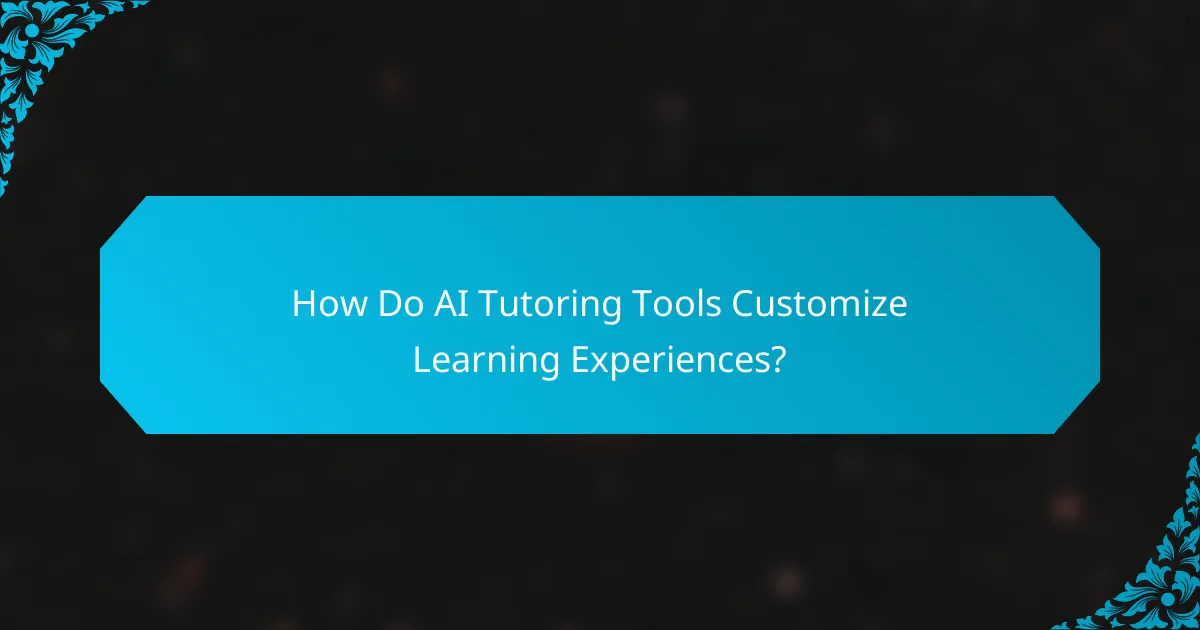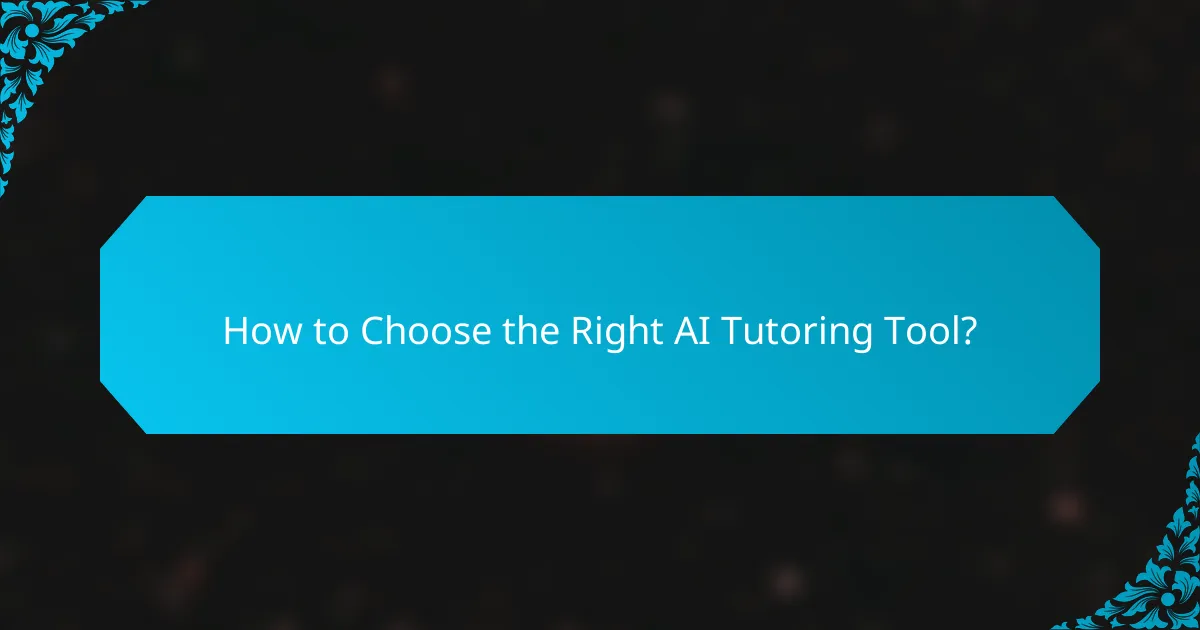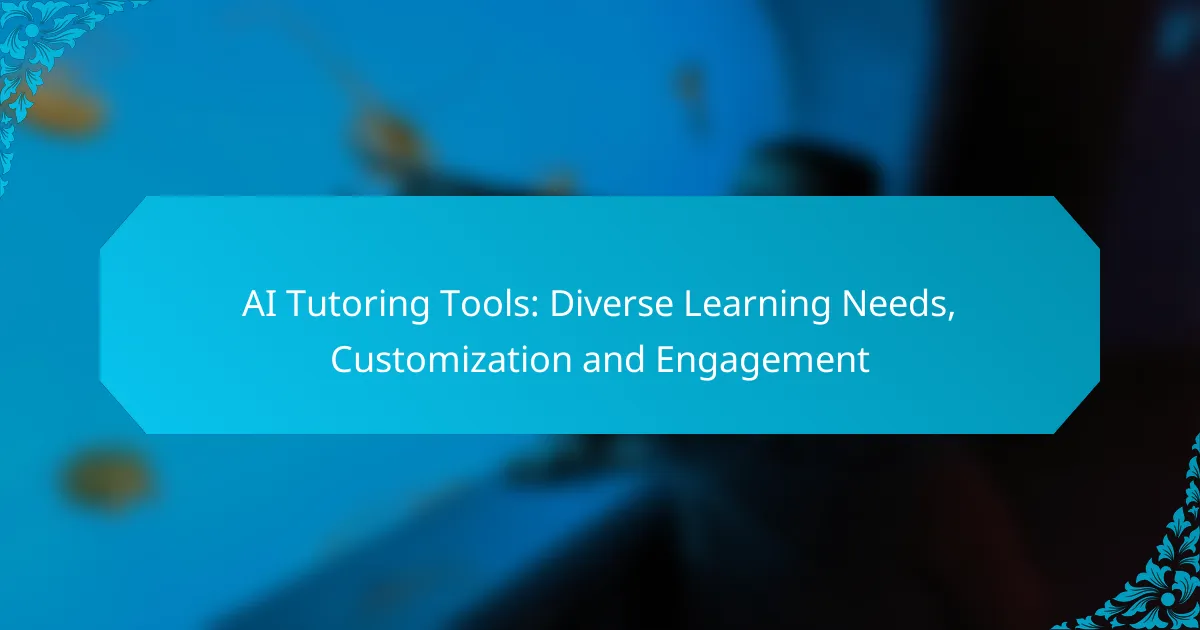AI tutoring tools are revolutionizing education by addressing diverse learning needs through personalized experiences and adaptive content. By leveraging advanced algorithms, these platforms create customized educational pathways that enhance engagement and effectiveness for learners of all backgrounds. With strategies like gamification and interactive content, they not only motivate students but also foster collaboration and social learning.

What Are the Best AI Tutoring Tools for Diverse Learning Needs?
The best AI tutoring tools cater to various learning needs by offering personalized experiences, adaptive content, and engaging methods. These platforms utilize advanced algorithms to assess individual progress and tailor lessons accordingly, making them effective for learners of all backgrounds.
Khan Academy
Khan Academy provides a comprehensive library of instructional videos and practice exercises across subjects like math, science, and humanities. Its adaptive learning technology assesses student performance and recommends resources to strengthen weak areas.
Students can set personal goals and track their progress, which fosters motivation. The platform is free, making it accessible to a broad audience, including those in low-income households.
Duolingo
Duolingo specializes in language learning through gamified lessons that adapt to the user’s proficiency level. Its bite-sized exercises keep learners engaged and encourage daily practice, which is crucial for language retention.
The app offers a variety of languages and uses a spaced repetition system to reinforce vocabulary and grammar. Users can set daily goals and receive reminders, promoting consistent learning habits.
Coursera
Coursera partners with universities and organizations to offer courses across diverse fields, from computer science to arts. The platform allows learners to choose courses that fit their interests and skill levels, often providing certificates upon completion.
Many courses are free to audit, with optional paid features for graded assignments and certificates. This flexibility makes it suitable for both casual learners and professionals seeking to upskill.
Wyzant
Wyzant connects students with qualified tutors for personalized, one-on-one learning experiences. Users can browse tutor profiles, read reviews, and select based on their specific needs and budget.
The platform supports various subjects and allows for both in-person and online sessions, catering to diverse learning preferences. Pricing varies by tutor, providing options for different financial situations.
Chegg
Chegg offers a range of educational services, including textbook rentals, homework help, and tutoring. Its AI-driven platform provides instant answers to questions and connects students with tutors for more complex subjects.
Chegg’s subscription model offers unlimited access to resources, making it a cost-effective solution for students needing ongoing support. The platform is particularly useful for college students managing multiple subjects and deadlines.

How Do AI Tutoring Tools Customize Learning Experiences?
AI tutoring tools customize learning experiences by leveraging advanced technologies to adapt to individual student needs. These tools analyze performance data and learning styles to create tailored educational pathways that enhance engagement and effectiveness.
Adaptive Learning Algorithms
Adaptive learning algorithms are designed to modify content delivery based on a learner’s progress and understanding. They assess responses in real-time, adjusting the difficulty level and types of questions presented to maintain an optimal challenge for the student.
For example, if a student struggles with a specific math concept, the algorithm may provide additional practice problems or alternative explanations until the student demonstrates mastery. This personalized approach helps prevent frustration and fosters a more supportive learning environment.
Personalized Learning Paths
Personalized learning paths allow students to follow a customized curriculum that aligns with their interests and academic goals. These paths are created based on initial assessments and ongoing performance metrics, ensuring that learners engage with material that resonates with them.
For instance, a student interested in science may receive more in-depth resources and projects related to that field, while another student may focus on literature. This tailored approach not only boosts motivation but also enhances retention and comprehension of the subject matter.
Real-Time Feedback Mechanisms
Real-time feedback mechanisms provide immediate insights into a student’s performance, helping them understand their strengths and areas for improvement. This instant feedback can come in various forms, such as scores, hints, or suggestions for further study.
For example, if a student answers a question incorrectly, the system can immediately offer a hint or direct them to relevant resources. This timely intervention encourages self-correction and promotes a growth mindset, allowing students to learn from their mistakes effectively.

What Engagement Strategies Do AI Tutoring Tools Use?
AI tutoring tools employ various engagement strategies to enhance learning experiences, including gamification, interactive content, and social learning features. These strategies aim to motivate students, personalize learning, and foster collaboration.
Gamification Elements
Gamification incorporates game-like features into educational content to boost motivation and engagement. Common elements include points, badges, leaderboards, and challenges that encourage students to complete tasks and achieve goals.
For instance, a tutoring platform might reward students with points for completing quizzes or reaching learning milestones. This approach can increase participation and make learning more enjoyable.
Interactive Content
Interactive content involves activities that require active participation from students, such as quizzes, simulations, and drag-and-drop exercises. This type of content helps reinforce concepts and allows learners to apply knowledge in real-time.
AI tutoring tools often use adaptive learning technologies to tailor interactive content based on individual performance, ensuring that students are challenged appropriately. For example, if a student struggles with a particular topic, the system may provide additional practice problems to strengthen understanding.
Social Learning Features
Social learning features facilitate collaboration and communication among students, enhancing the learning experience. These may include discussion forums, group projects, and peer feedback mechanisms that allow learners to share insights and support each other.
For example, an AI tutoring platform might enable students to form study groups or participate in collaborative assignments, fostering a sense of community. This approach not only improves engagement but also helps students develop critical social skills essential for their future careers.

How to Choose the Right AI Tutoring Tool?
Choosing the right AI tutoring tool involves assessing your specific learning objectives, evaluating user experience, and considering budget constraints. Each of these factors plays a crucial role in ensuring the tool meets diverse learning needs effectively.
Assess Learning Objectives
Start by clearly defining what you aim to achieve with the AI tutoring tool. Are you looking to improve grades in specific subjects, enhance critical thinking skills, or support language learning? Understanding your goals will help you select a tool that aligns with these objectives.
Different tools cater to various learning styles and subjects. For instance, some may focus on interactive problem-solving, while others emphasize personalized feedback. Make a list of your priorities to narrow down your options effectively.
Evaluate User Experience
User experience is critical in determining how effectively a tutoring tool can engage learners. Look for features such as intuitive navigation, interactive elements, and responsive design. A tool that is easy to use will likely encourage more frequent and productive engagement.
Consider trial periods or demos to assess usability. Pay attention to how the tool adapts to individual learning paces and preferences. A positive user experience can significantly enhance motivation and retention of knowledge.
Consider Budget Constraints
Budget is a significant factor when selecting an AI tutoring tool. Prices can vary widely, from free options to subscription models costing several hundred dollars annually. Determine your budget range early on to filter out tools that are not financially viable.
Look for tools that offer flexible payment plans or discounts for long-term subscriptions. Additionally, consider the potential return on investment; a higher upfront cost may be justified if the tool significantly improves learning outcomes.

What Are the Benefits of AI Tutoring Tools?
AI tutoring tools offer personalized learning experiences that cater to diverse educational needs, enhancing engagement and effectiveness. These tools leverage technology to provide tailored support, making learning more accessible and efficient for students of all backgrounds.
Enhanced Accessibility
AI tutoring tools significantly improve accessibility for learners by providing resources that can be accessed anytime and anywhere. This flexibility allows students with varying schedules or those in remote locations to engage with educational content without barriers.
Moreover, these tools often include features like text-to-speech and language translation, which can assist students with disabilities or those who are non-native speakers. By accommodating different learning styles and needs, AI tutoring promotes inclusivity in education.
Scalable Learning Solutions
AI tutoring tools can easily scale to accommodate a large number of students simultaneously, making them ideal for classrooms and online learning environments. This scalability means that educational institutions can implement these tools without significant additional resources.
For instance, a single AI platform can support hundreds of learners, providing each with customized feedback and resources. This efficiency allows educators to focus on more complex teaching tasks while the AI handles routine queries and assessments.
Data-Driven Insights
AI tutoring tools generate valuable data on student performance and engagement, which educators can use to refine their teaching strategies. By analyzing patterns in learning behaviors, these tools help identify strengths and weaknesses in individual students.
Educators can leverage these insights to tailor their instruction, ensuring that they address specific learning gaps. Additionally, this data can inform curriculum development and help in making informed decisions about resource allocation within educational settings.

What Are the Limitations of AI Tutoring Tools?
AI tutoring tools have several limitations that can affect their effectiveness. While they can provide personalized learning experiences, they often lack the ability to fully understand complex human emotions and unique learning styles.
Inability to Fully Understand Human Emotions
AI tutoring tools may struggle to interpret emotional cues, which can hinder their ability to provide appropriate support. For instance, a student feeling frustrated may not receive the empathetic response they need, leading to disengagement.
While some advanced AI systems can analyze text for sentiment, they often miss the nuances of human interaction. This limitation can result in a less supportive learning environment, making it essential for educators to supplement AI tools with human interaction.
Limited Adaptability to Unique Learning Styles
AI tutoring tools typically rely on algorithms that may not accommodate every student’s individual learning style. For example, a student who learns best through hands-on activities might find a purely digital approach less effective.
To address this, educators should consider integrating AI tools with diverse teaching methods. Combining traditional instruction with AI can help cater to various learning preferences, enhancing overall educational outcomes.
Dependence on Quality of Input Data
The effectiveness of AI tutoring tools is heavily dependent on the quality of the data they are trained on. Poor or biased data can lead to inaccurate assessments and recommendations, ultimately affecting student learning.
Educators should be aware of this limitation and ensure that the AI tools they use are regularly updated with high-quality, diverse data. This practice can help maintain the relevance and accuracy of the tutoring experience.
Potential for Over-Reliance
Students may become overly reliant on AI tutoring tools, which can diminish their critical thinking and problem-solving skills. If students depend solely on AI for answers, they might miss opportunities to develop essential cognitive abilities.
To mitigate this risk, educators should encourage a balanced approach that promotes independent thinking. Integrating AI tools as a supplement rather than a replacement for traditional learning methods can foster a more well-rounded educational experience.
